Maxwell’s Guide Book to the Stewartry of Kirkcudbright
from the Nith to the Cree.
Published Castle Douglas & Kirkcudbright,
1878
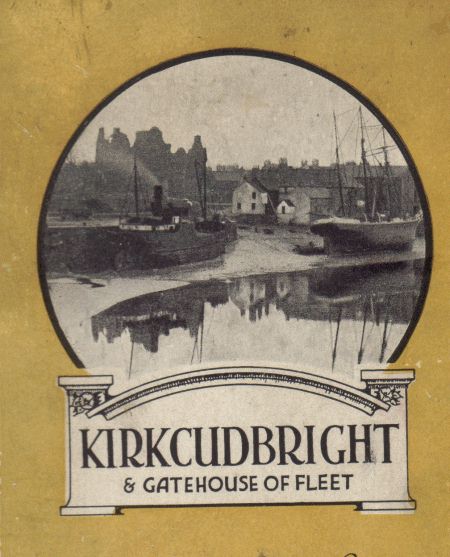
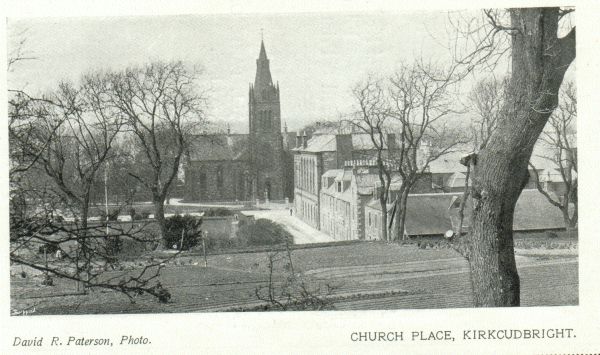
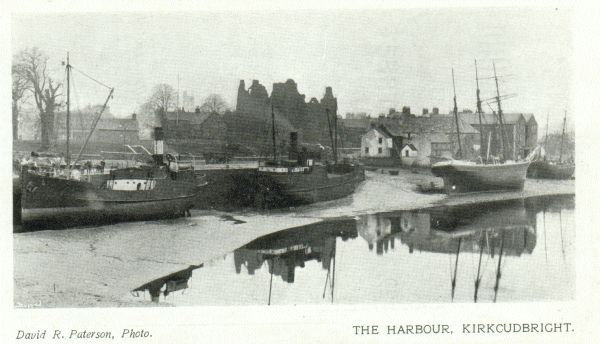
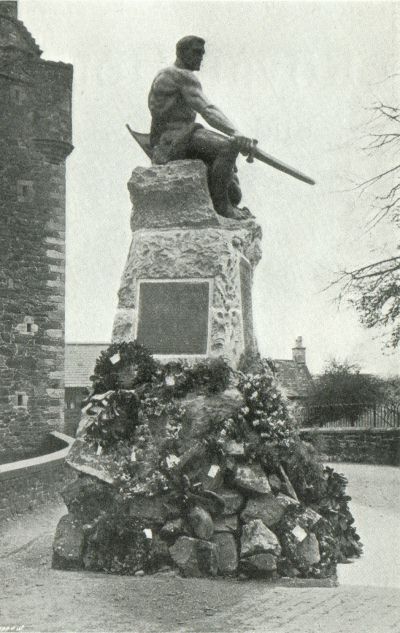
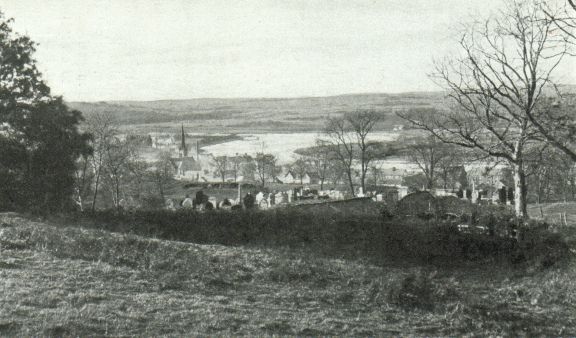
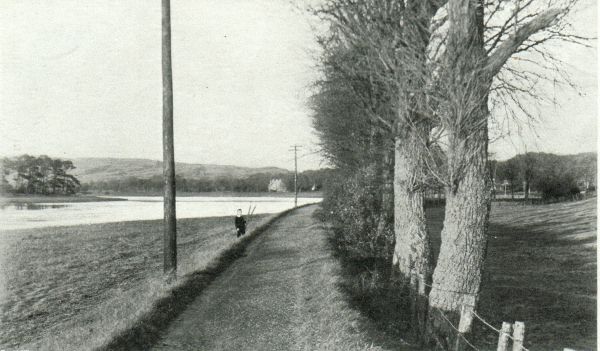
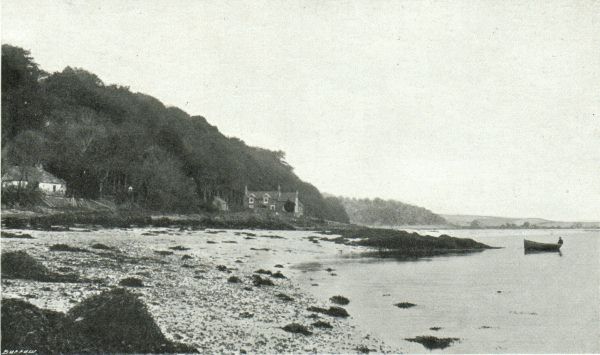
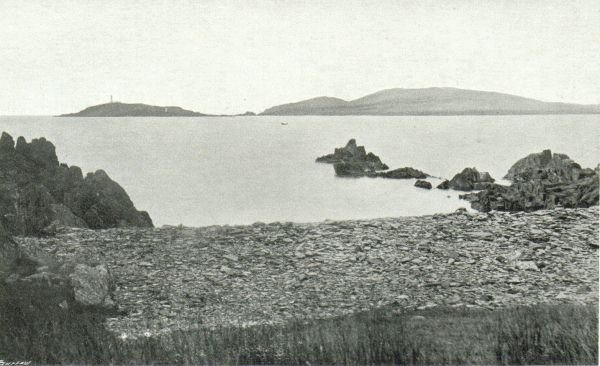
The section reproduced is that which refers to Kirkcudbright & its environs.
TO KIRKCUDBRIGHT BY RAIL. Leaving Castle-Douglas, we now take train for the county town, situated ten miles to the south-west, through a beautiful and picturesque country. Two miles along the line a view of the old castle of Thrieve is obtained on the west, and to the east will be observed the new mansion-house of Thrieve. It is finely situated, and commands a magnificent view of a lovely portion of the vale of Dee. Before reaching the Bridge-of-Dee station there is seen the fine stone bridge across the river, which at this point and others has a most picturesque appearance.
On the railway between and Tarff Station (for Twynholm and Gatehouse) there is seen the mansion-house of Dildawn, the residence of John Cowan, Esq. ; and three miles further on the visitor passes a few farm-houses before observing the estate of Queenshill, the residence of Colonel Walter Montgomerie Neilson, son of the late James Beaumont Neilson, Esq., the celebrated inventor of the “Hot-Blast.” The house is embosomed among trees, and only a very small portion of it is visible from the railway carriage. At this point the village of Ringford lies in the hollow, and between it and Tarff station — passing Meikiewood (Mr Fraser) — there is one of the finest glimpses of woodland which can be witnessed in any portion of the South of Scotland. The mansions of Barcaple, Valleyfield, and Largs, and the Free Church of Tongland (Rev. P. Fisher), occupy prominent positions in the landscape. A little further on to the west we pass the estate of Chapel, the farm of Underwood, and on the opposite side lies Cumpston House, the residence of Mr Maitland of Dundrennan. It is situated near the confluence of the Tarff and Dee,
“Where windin Tarff, by broomy knowes,
Wi’ siller waves to saut sea rows,
And mony a greenwood cluster grows,
And harebells bloomin’ bonnie, 0.”
History narrates that at Cumpston Castle (a fine old ruin) Montgomery, the poet, composed ‘The Cherry and the Slae,’ in which the following lines are given as descriptive of the flooded river Dee as seen from the old bridge at Tongland
“But as I looked me alane,
I saw a river rin
Out o’er a steepie rock of stane,
Sine lichted in a lin,
With tumbling and rumbling
Amang the rocks round,
Devalling and falling
Into a pit profound.”
We are now approaching a most picturesque portion of the route to Kirkcudbright, of which, at this point, the visitor can merely catch a glimpse up and down the river Dee. When it is in flood the water comes down the rapids between the old bridge of Tongland and the new railway bridge—which the tourist is now supposed to be crossing — with impetuous foam, and has a grand appearance. Near the bridge is the Parish Church (Rev. George MacInnes, B.D., minister), Manse, and village of Tongland, and a short distance above, the artificial salmon breeding pond was situated. The Tongland fishery is leased by Mr Gillone, who has at the same place a large baking and biscuit manufactory. The visitor, however, might take a conveyance from Kirkcudbright to visit these places, and return to Castle-Douglas by Tongland Bridge, Ashton Villa, Low Clauchan, Ellerslie, the Doachs and Fishery, the Park of Tongland, and Argrennan Wood, which they would find a pleasant change from the rail.
But to continue our route. Immediately after crossing the Prince of Wales Railway Bridge (from which the visitor will observe Tongland Bridge) built by the celebrated Telford, and one of the earliest in the country, we pass the farmhouse of Carse (Mr Phillips), on the west side. A little further on, to the east, on the rising ground, can be seen the mansion-house of Ardendee, the residence of George Hamilton, Esq., Sheriff-Clerk of the county. It is most beautifully situated, and commands one of the finest views of the river Dee and surrounding scenery which can be obtained in the district. Nearing the town we pass St Cuthbert’s Villa (Alexander Dunbar, Esq.), Ellenhank (R. M. Gordon, Esq. of Rattra, Clerk to the Commissioners of Supply for the county), Fludha Cottage (Miss Maitland), and on the other side of the public road is Janefield (Miss Mackenzie) and Neptune Park (Mr T. Williamson). On the east side of the line at this point will be observed the Combination Poorhouse, a large square building, built of mixed whinstone. Coming nearer the town a number of handsome villas have been erected at Lansdown Place and Mansfield (Provost Williamson), and there is one being built for John M’Kie, Esq., and another for Mr W. Tait, almost immediately opposite.
Nearer the town a substantial block of building has been erected, and let to respectable poor inhabitants at a moderate rent. Gardens are placed in front of the houses, which are built with the windows fronting the road. For this gift the burgh is indebted to a generous native of Kirkcudbright resident in London, who, “doing good by stealth, and blushing to find it fame,” sends a sum of £100 every now and again to the Rev. John Underwood, minister of the parish, who has expended the gift as we have stated. We have now reached the railway terminus at
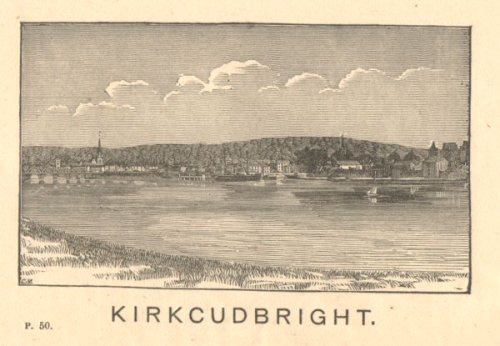
KIRKCUDBRIGHT, and before proceeding to take the visitor further, a slight sketch of the history of this ancient royal burgh may not be uninteresting. Its name is supposed to have been derived from the famous Saint Cuthbert, and the churchyard still retains that name, Kirk-Cuthbert being easily transformed into Kirkcudbright. In very early times it was called Benutium ; its Celtic name was Caer-cuabrit, and the modern name of the town was spelt in different ways—Kilcubright, Kirkcubrie, and Kilcubrig. In ordinary conversation it is usually called Kirkcubri.
The parish is rich in historical events, and the town is said to have existed before the invasion of the Romans. It is on record that Agricola, with his victorious army, penetrated into the parish in the year of our Lord 82, and that the Romans held possession of forts in the neighbourhood of the town for nearly 300 years. Whilst Malcolm IV., son of David I., was a minor, Fergus, the lord of Galloway (whose palace stood on an island on the farm of Lochfergus, situated a little more than a mile from the town), asserted his independence as a Scottish prince. Malcolm determined to chastise him, but on his first two trials failed. The third time, however, he was successful. In 1160, Fergus resigned the Lordship of Galloway, and next year died of grief at Holyrood Palace. He was ancestor of Bruce and Baliol, and from him the royal family of Britain is descended. In the castle of Lochfergus Uchtred and Gilbert, sons of Edward, quarrelled, the latter murdering the former in a most barbarous manner. Allan, the last in the male line of the ancient princes of Galloway, is supposed to have died in this castle, or at Kirkcudbright castle, and was buried in Dundrennan Abbey, founded by Fergus, his great-grandfather.
Sir William Wallace, the patriot, after his defeat at Falkirk, took shipping at Kirkcudbright, and sailed to France with Maclellan of Bombie, ancestor of the noble family of Kirkcudbright, and about fifty faithful adherents. Edward I. remained at the castle with his Queen and Court in the course of his career of conquest, and from the port sent into England and Ireland large quantities of wheat to be made into flour. The King, while resident in the burgh, would allow no trading or friendly intercourse with the Continent, especially France, except from selected ports, of which Kirkcudbright was one, and the privilege was guarded in this case with such jealousy, that any person wishing to leave the country with sealed letters, or was suspected of a design to carry messages abroad, was ordered to be kept in prison till the King’s pleasure was known regarding him.
Galloway having been shortly afterwards subdued by Edward Bruce, he received from his brother the lordship of the province, with the castle of Kirkcudbright, and all Baliol’s forfeited estates. In 1501 the town had the honour of a visit from King James IV. In 1507 Kirkcudbright was nearly destroyed by a body of furious Manxmen, under Thomas, Earl of Derby ; and for some years afterwards many of the houses remained in ruins. In 1509 King James again visited the burgh, and granted the inhabitants the castle and its lands. This was afterwards confirmed by charter. In 1523 the Duke of Albany landed at Kirkcudbright, and when the town was summoned to submit to the authority of Edward VI., it refused to do so, and the inhabitants having received notice of the approach of the invaders, they “barred their gates, and kept their dykes, for the town was dyked on both sides, with a gate to the water-ward, and a gate at the over-end to the fell-ward.” The English attack was not successful, and they returned to Dumfries.
After Queen Mary’s army was defeated at Langside, she fled into Galloway, travelling, it is alleged, along the west side of the Ken, and, crossing the Dee near Tongland church, she entered the parish of Kirkcudbright, taking refuge in a cottage on the farm of Culdoach, where she remained three days. Philip, King of Spain, thinking to avenge the defeat of Mary and her wrongs, fitted out a stupendous fleet, and collected a vast army for the invasion of Britain, the place fixed for the landing being the harbour of Kirkcudbright. The fate of the Armada is well known.

James VI., in 1587, visited the royal burgh, and a small silver gun was presented by him to the incorporated trades. The miniature silver cannon was shot for by members of the Incorporated Trades in 1781 in 1830; in 1838, on the day of the Queen’s coronation, when the wassail howl was also filled, and has been subsequently used on laying the foundation stones of the Prince of Wales and Kirkcudbright Bridges. Charles IV. granted a new charter to the burgh in 1633, which created the present corporation, consisting of a provost, two bailies, a treasurer, and thirteen councillors.
Let this sketch suffice for the ancient history of the burgh, as we will introduce in the course of our ramble over the town and its vicinity various incidents touching on the places we visit. Opposite the railway station will be observed the Johnstone Free School—an excellent seminary, free to all the children of residents. Next to it there is a very handsome new Free Church (Rev. A. Marshall, minister), the foundation stone of which was laid by Thomas Cochrane, Esq., New York, on the 20th of August, 1872. It is one of the most handsome edifices in the south-west of Scotland, with a square tower and an elegant spire, 120 feet in height, which terminates with a highly ornamental finial. The principal portion of the building is of whinstone, with red freestone sides and insertions, the cusps in each window being pointed Gothic. The inside of the church is very handsome, there being a beautiful stained-glass window at the back of the pulpit, filled with a geometrical design. The church is seated to accommodate 712 persons. It was opened by the Rev. Dr Buchanan, of Glasgow, on the 26th of March, 1874.
At the end of St. Mary’s Street, the visitor will observe the Royal Hotel (Mr M. M’Kenzie); at the opposite corner the Commercial Hotel (Mr D. Stewart)—both excellent houses for apartments and entertainment. There is also the George Hotel (Mr J. Swan) close by. In passing along St. Cuthbert Street we observe the Commercial Bank (agent—S. Cavan, Esq.), and opposite to it is the harbour, with shed, recently enclosed on three sides. The Countess of Galloway, or other steamer (owners, Messrs M. Langlands & Co., Glasgow and Liverpool ; agent, Mr Samuel Cavan) sails for Liverpool weekly, or oftener during the season, and there are a number of vessels trade in the port with timber for Messrs W. Thomson & Co., Dumfries, who have a large woodyard on the Moat Brae, near the quay. Messrs J. and T. Williamson also import guano and grain largely; and there are several other vessels connected with the port, which maintains a harbour master.
While at this point, the visitor might walk to the new bridge, which was finished in 1866, at a cost of £10,000. To reach the western side of the river Dee, without making a detour by Tongland Bridge, a ferryboat was the only means of conveyance for many years. It was very unsafe and inconvenient, leading to fatal accidents. In 1848 William Ireland, Esq. of Barbey, Steward-Substitute of Kirkcudbright, was drowned while crossing in his carriage on board the boat. This led the way to the consideration of the erection of a bridge, but nothing was done for nearly twenty years afterwards. Samuel Cavan, Esq., was elected Provost of the Burgh in 1862, and about the end of 1864 he agitated the matter so successfully that the bridge was opened, as already stated, and the whole debt was paid off in 1876. The bridge is of the bow-string lattice structure — its length being 500 feet by 23 feet broad, consisting of five fixed spans of 71 feet each, and a compound span of 68 feet, which latter turns on a cast-iron cylinder filled with concrete, to allow of the passage of vessels of burden beyond the bridge up to Tongland. The traffic, however, is not great.
The piers, over which stands a square column, furnished with a tripod lamp-stand and globular lamps, are clustered columns, with fluted capitals, four of the columns being surrounded with an entablature, the whole forming a bridge of the most graceful description, and admirably suited for the position in which it is placed, being at once in harmony and contrast with the surrounding picturesque scenery. A particular look should be taken from the west end of the bridge, where there is one of the finest views of the river, from Ardendee downwards, and also of the town and its neighbourhood. There are also some fine walks by the side of the Dee for several miles. At the east end will be seen the following inscription.

Looking towards the south the most attractive object to the eye of the visitor is the old castle, clad with ivy from the foundation to the summit.
“A dainty plant is the ivy green,
Which creepeth o’er ruins old.”
It stands near the margin of the river, and adds much to the picturesque beauty of the town. The castle was built on the site of the Franciscan Friary in 1582, by Sir Thomas Maclellan of Bombie, and bears that date on the escutcheon above the doorway. It is the property of the Earl of Selkirk. The Female School is immediately adjacent. Passing along Castle Street, on the right hand side, will be observed the National Bank (agent, R. M. Gordon, Esq.), built of red freestone.
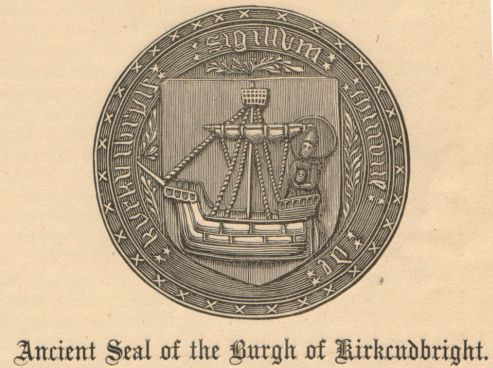
In High Street are the County Buildings. Seen from a distance, the castellated tower of the old jail forms a conspicuous landmark. It is now connected with, and approached by the new and handsome court-house erected a few years ago, at a cost of £8,583, and admission to it may be obtained on application to the keeper — Mr Osborne. We commend every visitor to the burgh to proceed to the top of the tower. The view of the Solway, the Ross Lighthouse, the Dee, the town, the old castle, and the surrounding country, is simply magnificent, and will well repay the labour of the ascent. At the back of the court-house are the offices of the County Constabulary, with rooms for the Chief Constable (Mr Alexander Davidson) and Superintendent (Mr Watson); also the County prison (Mr William Geddes, governor), a large plain building, excellently adapted for its purpose, and containing twenty-six cells.
On the opposite side of the street stands the old court-house and jail—a very curious edifice, surmounted with a small tower and spire, and having an ancient moveable clock, with one hand. This is the market cross, and it is here where the wassail bowl is filled on festive occasions. It was last used in 1863, on the marriage of the Prince of Wales. It is made of walnut, hooped with brass, and holds ten gallons. Here also hung the jougs in feudal ages, but they have been removed, their presence not being necessary in these enlightened times. A portion of the old building is occupied as an armoury and drill room for the 1st K.R.V. The public well here occupies a prominent position, and on the front of it is a tablet with the following inscription
This fount, not riches, life supplies,
Art gives what nature here denies,
Posterity must surely bless
St. Cuthbert’s sons who purchased this.
At the corner of High Street is the U. P. Church — Rev. W. Watson, minister. Steps are being taken to erect a new United Presbyterian Church on another site, the present one being incommodious and not well situated. The Castle Dykes may be next visited. After a very pretty walk by the side of the river and through the adjacent parks, the visitor may return by the Academy, celebrated for the excellent classical, commercial, and English education imparted within its walls. It is a large plain building, with a portico in front, affording shelter to the scholars in bad weather, and is surrounded by an excellent play-ground, on a portion of which the appliances for a gymnasium are placed. There are three masters in the institution—the Classical department, Mr Watson, A.M., rector; the English department, Mr Blacklock; and the Mathematical department, Mr Smith, each having separate rooms. The attendance of pupils is numerous, and they come from all quarters of the globe. Mr R. Smith, F.E.I.S., the mathematical master, has an excellent boarding establishment for boys at Broughton House, situated in High Street, close to the river. In connection with the Academy we may mention the name of the Rev. William Mackenzie, author of the History of Galloway, who was a native of the Burgh, and English master from 1809 to 1837. He was licensed as a preacher in 1818, and in 1843 was ordained minister to the parish of Skirling, where he died in 1854, in his sixty-fourth year. Dr Cranstoun, now of Dumfries Academy, was rector of Kirkcudbright Academy for several years.
Returning by the upper end of High Street the visitor will observe the Selkirk Arms Hotel (Mr Carter) in a prominent position. Turning to the right we near the approach to St Mary’s Isle, the residence of the Earl of Selkirk. The entrance gate is of a plain and unornamented design, and the mansion-house is a substantial looking building, situated fully a mile to the south, and embowered in the trees of a finely situated peninsula. Near the house there is a beautiful garden and conservatory. In the year 1798 the celebrated Paul Jones — a native of Kirkbean — paid a rather unwelcome visit to St Mary’s Isle, with the intention of carrying away its noble owner, the then Earl of Selkirk. The absence of the Earl in England caused some disappointment to the pirate and his crew, and some of the party were despatched to the mansion-house to demand the silver-plate. Various articles were delivered to them by the Countess of Selkirk, and conveyed to the ship. Jones, however, some time after, took a remorse of conscience, bought the plate again in France at a large sum, and returned it in safety to her ladyship.
The battery of the Kirkcudbright Artillery is situated on a portion of St Mary’s Isle, at the head of the Manxman’s Lake. Leaving by the east gate, or Little Cross, the visitor will probably return to the town by the public road, but if he wishes to pursue his course to the east he will reach the Saw Mill (Mr John Gordon). In the cottages built in the immediate vicinity several families take up their residence during the summer season for sea-bathing. Further on in the same direction are situated the farm-house of Torrs (Mr Barber) and the mansion-house of Balmae (W. Gordon, Esq.) From this point a beautiful view of the Solway is obtained. The Ross light-house, at the mouth of the Dee, and the Isle of Man in the distance, with the English coast to the east, and Wigtownshire to the west, form a magnificent sight. Galtway (or Gata) Church stood about two miles, and Dunrod Church about three and a half miles, from the burgh. It is said that both were united to Kirkcudbright in 1663.
The visitor will now return to the town, and coming along St Mary’s Street we pass on the left two beautiful bowling-greens, formed a few years ago by the Kirkcudbright Bowling Club. The game is a great favourite in the county, and forms one of the principal amusements during the summer months. Near to the bowling-green is the site of the new Town Hall, now in course of erection. It will be a capacious building, including within its walls a hall for public meetings, lectures, concerts, &c. ; library and reading-room for the Institute; chambers for the Magistrates and Town Council; room for a museum, &c. At the head of Church Place a new subscription Billiard Club room was erected in 1877, and affords a quiet pastime for its members.
A short distance from the Hall is the Bank of Scotland (agent, D. M’Lellan. Esq.) a large and very handsome building of white freestone, very tastefully designed and ornamented. On the opposite side, in the midst of fine old trees, and surrounded by a substantial stone-wall, stands the Parish Church (Rev. John Underwood, minister). It is a large and elegant building, capable of containing upwards of 1500 people, and was completed in 1838 at an expense of about £7000. It has a handsome spire and clock. John Welsh, son-in-law of John Knox, was minister of the parish. He was banished from Britain for his opposition to Episcopal encroachment, but was latterly allowed to reside in London, where he died in 1622. In 1750 John Maclellan occupied the pulpit, and Dr Thomas Blacklock, who had been blind almost from his infancy, was ordained to the pastoral charge of the parish in 1762. His settlement was so strenuously opposed that he felt himself compelled to resign the living and retire to Edinburgh. William Crombie succeeded him in 1765, Robert Muter in 1770, George Hamilton in 1820, and the late John M’Millan in 1837.
Inside the church, on the right of the pulpit, there is a handsome monument to the memory of the Rev. George Hamilton, who took a very active part in obtaining its erection. Leaving the church grounds the visitor now proceeds northward, passing on the left the Roman Catholic place of worship, and on the right the Lifeboat Station, containing a lifeboat and all the necessary fittings. Before diverging to the left, a little further up the hill, will be observed the new Manse, built for the present minister of the Parish Church. It stands in a beautiful situation, and commands an extensive view of the river and surrounding scenery.
The road to the churchyard is opposite the avenue, and the entrance gate is on a very ancient model. The church was originally dedicated to Saint Cuthbert, and given by Uchtred, son of Fergus, Lord of Galloway, in the 12th century, to the monks of Holyrood, and was a vicarage under them till the Reformation. When Episcopacy was established it reverted to the crown. Those having a little Old Mortality taste could easily spend a grave hour among the tombs, several of the inscriptions on the stones informing us of those who died in the glorious cause of the Covenant, and whose memory is kept green by the narrative of their deeds. On one of the tombstones, nearly 200 years old, we read the following: —
WILLIAM HUNTRE — ROBERT SMITH — 1654.
This monument will show posterity
Two headles martyres under it doth ly.
By bloody Grahame were taken and surpris’d,
Brought to this toune, and afterwards were saiz’d,
By unjust law were sentenced to die;
Them first were hang’d, then ‘headed cruelly.
Captains Douglas, Bruce, Grahame of Claverhous
Were those that caused them to be handled thus;
And when they were into the gibbet come
To stop their speech they did beat up the drum,
And all because that they would not comply
With indulgen and bloody prelacie—
In face of cruel Bruce, Douglas, and Grahame,
They did maintain that Christ was Lord suprearn,
And boldly owned both the covenants—
At Kirkcudbright thus ended those two saints.
In the following year John Hallume also fell a victim for his adherence to “Scotland’s Reformation Covenants National and Solemn League.” An ancient stone, the words on which are illegible, is dated 1620. Another, dated 1590, is erected in memory of John Shaw. A monumental stone erected to Jean, spouse of James Malcolme, late provost of Kirkcudbright, dated 1710. The burial-place of Miss Fitzpatrick, ancestor of Eugenie, Empress of the French, the family of Ewart, distantly connected with William Ewart, Esq., who represented the Burgh in Parliament for many years, and other well-known families are recorded as having found their last resting-place in the “Auld Kirkyard.” The Ewart burying ground is near the entrance, and the inscription on the tombstone can be deciphered by the student of archaeology.
A most curious and interesting stone has also been erected to the memory of Billy Marshall, the famous Gallovidian gipsy or tinker. The one side bears the inscription — “The remains of Wm. Marshall, tinkler, who died 28 November, 1792, at the advanced age of 120 years.” On the other side of the stone there is carved two ram’s horns and two table spoons crossed. A curious anecdote is told of this tinkler body. He joined the army, and went to the wars in Flanders, and one day accosted his commanding officer—a Galloway gentleman — thus — ” Sir, hae ye ony word to sen’ to your friends in Scotland at present ?” “What by that !” returned the officer; “is there any person going home ?” “Ay,” continued Billy, “Keltonhill Fair is just at han’. I hae never been absent frae it since my shanks were able to carry me to it, nor do I intend to let this year be the first.” The officer, knowing his nature, thought it would be in vain to try to keep him in the ranks, so bade him tell his father and friends how he was; he also gave him a note to take to his sweetheart. So Marshall departed, was at Keltonhill accordingly, and ever after that paid much respect to the family of Maculloch of Ardwall, one of whom was the commanding officer alluded to.
Within the last two years the churchyard has been modernized, and is gradually being made to have the appearance of a cemetery. Before leaving the town we may mention generally that it is very pleasantly situated, and has a mild climate. The revenue of the burgh is considerable, and the inhabitants enjoy immunities which render it a desirable place of residence. It is well supplied with spring water, brought in pipes about half-a-mile distant. It was the first town in Galloway which introduced gas, which was done in 1838, under the auspices of a private company. Nearly every branch of trade is represented in it, although there is no establishment employing a very large number of men. The drapers’ shops are generally handsome, some of them being quite suitable for a much larger town. There are several builders, joiners, painters, cabinetmakers, watchmakers, and shops of other descriptions. The only steam-engine in use in the burgh belongs to Messrs M’Millan & Fisher, millwrights and joiners, whose premises are in High Street.
The following list of the Provosts of the Burgh since the beginning of the century may be deemed worthy of a place in our guide. It has been compiled by the author from the records of the Burgh in the possession of the Town Clerk (Mr M’Lellan) :—

We now suggest that the tourist should return to town, and rest at any of the hotels they may choose, and if they have a day to spare we ask them to be up betimes, get breakfast, hire a conveyance, and spend the “lang simmer day” in a trip to
DUNDRENNAN ABBEY.
Shortly after leaving Kirkcudbright the tourist passes the Manse, and proceeds by Kirkland Hill, crosses the Buckland Burn, passes Bombie farm-house (Mr Williamson), the mansionhouses of Gribdae (W. Bell, Esq.), and Auchengool, the farmhouses of Thorn and Kirkcarsewell (Mr G. C. Syminton), and keeping to the right, down the glen, finds himself shortly afterwards at the Dundrennan Arms (Mr S. Kirkpatrick).
